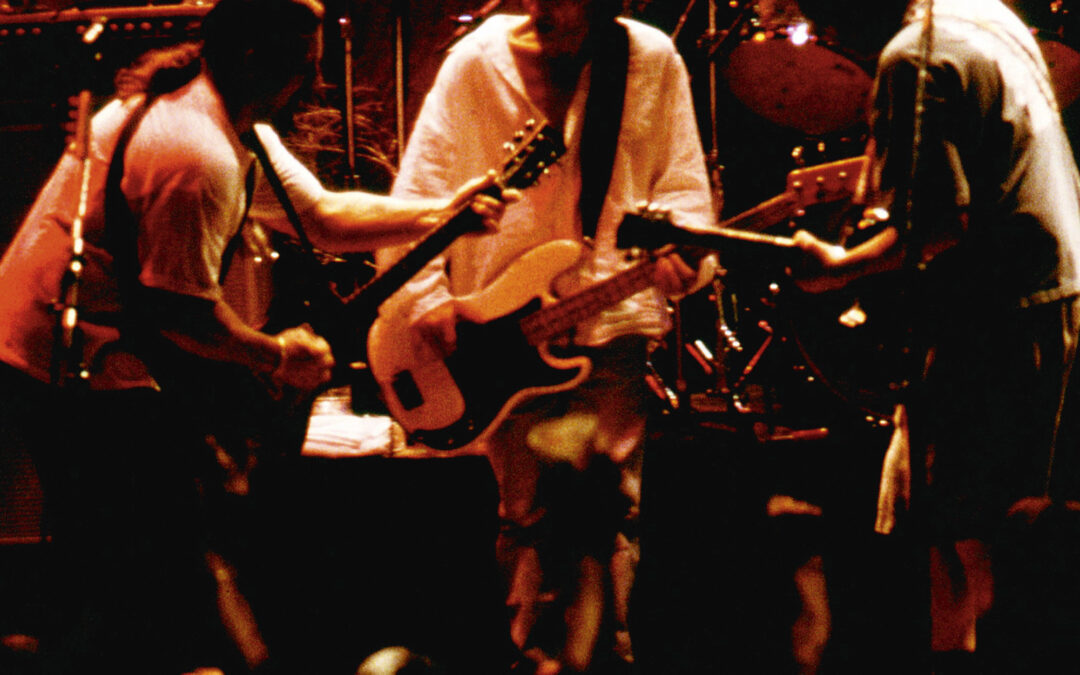After the Gold Rush
Created by fate, destined to crash’n’burn, Young’s first major band was a collection of “geniuses” who mixed up country, rock and pop – and launched two its members skywards.
Words: SYLVIE SIMMONS
RELEASED: September 19, 1970 / LABEL: Reprise / CHART: 7 (UK) | 8 (US)

Panning for gold: Neil Young & Crazy Horse rock out, 1970.
IN A REMARKABLY SHORT PERIOD Neil Young had released a debut solo album, an album as Neil Young & Crazy Horse, and another as a card-carrying member of Crosby, Stills, Nash & Young. Now here he was with a new solo album. A fan might have been forgiven for thinking that post-Buffalo Springfield Neil was still trying to work out who he was and what he wanted to do. The truth was he already knew – he was going to do whatever he wanted with whoever he wanted to do it, a rule he’s lived by ever since.
After The Gold Rush is a beauty. A strange beauty, its songs largely dreamlike, pensive, downright mournful on Neil’s lugubriously slow cover of Don Gibson’s 1957 country hit Oh, Lonesome Me. Yet Southern Man, the song considered its highlight, is Young at his most ferocious – an excoriating rock song performed with Crazy Horse attacking the racism of the American South.

These were strange times. In 1969 Young played at both Woodstock, the hippy dream, and at Altamont, its dark apocalypse. Ever an outsider, he had eschewed the hippy paradise of Laurel Canyon and bought a house in Topanga Canyon, a more secluded environment, which suited him fine. It also attracted the likes of Charles Manson, whom Neil had met and jammed with. The Topangan who became a very close friend, though, was David Briggs, a record producer who, like him, preferred records with a raw live sound.
A newer acquaintance was Dean Stockwell, a former TV child star who’d dropped out in the ’60s and moved into the hills. Encouraged by actor Dennis Hopper, he’d co-written a screenplay for a disaster movie called After The Gold Rush. Hopper assured him one of his movie connections would bite, but so far nothing. Neil’s wife Susan suggested he show it to the songwriter.
“Some songs were written on the spot. The title track was finished in half an hour.”
An ecological story about an innocent folk singer and a Biblical flood that ends human life on Earth? Of course Young loved it. He told Stockwell he wanted to direct it, act it, write the soundtrack, everything. The two of them did the rounds of the LA film studios to no avail. With the project shelved and his record label pressuring him for a new LP, Neil decided to borrow the title for his third solo album.
After The Gold Rush is not the soundtrack of an unmade movie; it’s not a Greendale. It’s not even a concept album. There were songs on it that Young had premiered on-stage with CSNY, including Southern Man, which he wrote in the basement of his Topanga house, and Don’t Let It Bring You Down, written on the first CSNY transatlantic tour. Graham Nash has said that Young wrote the sweet, sad Only Love Can Break Your Heart as a response to Nash’s break-up with Joni Mitchell.
Other songs “were written on the spot” the album’s producer Briggs told this writer decades later. Among them was the title track, which Briggs said took only half an hour to write.
Helping capture such moments of inspiration, Young had built a home studio in the basement, where most of this album was recorded. “Neil would sit upstairs in the living room and then we’d all go down to the basement, turn on the tapes, and away we’d go,” recalled Briggs.
Among the musicians in the studio were pals Stephen Stills, Nils Lofgren, Danny Whitten, Ralph Molina, Greg Reeves, Billy Talbot and Jack Nitzsche. Young said the album captured “the spirit of Topanga Canyon”, and, according to Briggs, if you listen closely, you can hear dogs barking outside.
The song that contained the spirit of the screenplay was the title track. A melancholic beauty, it told a surreal, dreamlike story set in the past – knights, peasants, archers; the present – a man getting high in a burned-out basement; and the future – aliens coming to Earth after its destruction to try to save what was left. “Look at Mother Nature on the run in the 1970s…”
In the 55 years since he sang those words, Young has returned to the subject in his music and movies over and over again.
TRACKS
Tell Me Why
After The Goldrush
Only Love Can Break Your Heart
Southern Man
Till The Morning Comes
Powderfinger
Oh, Lonesome Me
Don’t Let It Bring You Down
Birds
When You Dance I Can Really Love
I Believe In You
Cripple Creek Ferry

